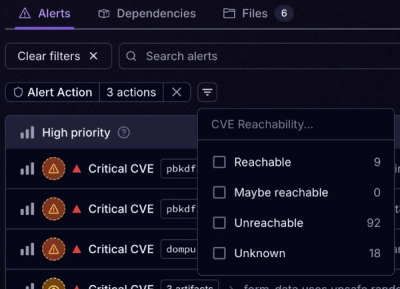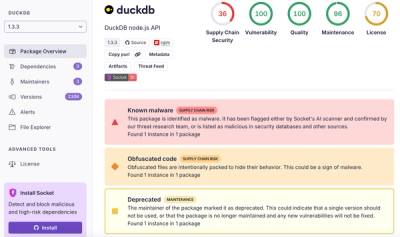
Product
Introducing Tier 1 Reachability: Precision CVE Triage for Enterprise Teams
Socket’s new Tier 1 Reachability filters out up to 80% of irrelevant CVEs, so security teams can focus on the vulnerabilities that matter.
Dataput is an npm package that integrates a database service without the need for external apps such as MySQL, but using JSON files created in your project folder.
This library is synchronous, so it doesn't use promises or callback functions.
npm init for creating package.jsonnpm i dataput --save for installing the packageFirst, we need to import the package into our sketch.
const Dataput = require('dataput');
We also need to declare the databases we want to use, whether they exist or not
So keep this code always in your sketch, even if it's the 1000th time you run it
const databaseLogin = new Dataput('DATABASE_NAME');
Once the database has been declared, if it does not exist the library will automatically create a folder (by default called 'storage', but it can be changed by setting the directory as the second parameter of the database declaration in the constructor) where it will then put the necessary files, which it will automatically create . In this case, it will create the directory: ./storage with the file ./storage/DATABASE_NAME.min.json
Each database is a table, you can create as many databases as you want, but it is important that for each of them the headers are set, that is the names of the columns (example: ID, Name, Surname). You can do it this way
databaseLogin.headers = ['ID', 'Name', 'Surname', 'Email address', 'Password'];
These headers can be changed when you want, and depending on the number of elements in the header, the content will adapt, so be careful because if we change the headers with a smaller number, some data in the content of the table will be deleted.
| ID | Name | Surname | Email address | Password |
|---|---|---|---|---|
| 1 | Simone | Fracassetti | simone@vocatus.space | ed347a07305214ab98974a008674eb78cd03b1fedb73c8be9f79e40fb8e155b0 |
If we remove the "Surname" header from this table, the contents of the table will adapt to the number of Headers, so we will lose the given password
| ID | Name | Email address | Password | |
|---|---|---|---|---|
| 1 | Simone | Fracassetti | simone@vocatus.space | ? Item deleted |
Many databases, if not all of them need a column that is a primary key and therefore that has a unique value, and often using autoincrement which is not necessary, it is very important to have it, to do this just use this syntax after the declaration database:
databaseLogin.autoIncrement = 'ID'
'ID' is the column that must have the property, and like the other options it can be changed later
Insert is used to insert a row into a database, and can be used simply like this:
databaseLogin.insert({
ID: Dataput.AI, // Dataput.AI is used to specify that the value should be automatically entered with autoincrement
Nome: 'Simone',
Cognome: 'Fracassetti',
'Indirizzo email': 'simone@vocatus.space',
Password: 'ed347a07305214ab98974a008674eb78cd03b1fedb73c8be9f79e40fb8e155b0'
});
As you can see, it is very easy to insert a line, just use an object in JSON format. The ID column as it has the autoincrement property can receive as content "Dataput.AI", which makes the library understand that it must insert the value automatically, if "Dataput.AI" is used on a column without this property, an error will be returned.
Insert is used to insert a row into a database, and can be used simply like this:
databaseLogin.delete({
Nome: 'Simone',
'Indirizzo email': 'simone@vocatus.space'
});
The delete method accepts as its only parameter a search that will be performed, and ** all ** rows that match the search will be deleted.
databaseLogin.updateRow({
Nome: 'Simone',
'Indirizzo email': 'simone@vocatus.space'
}, {
Nome: 'Andrea',
Cognome: 'Bergamaschi'
});
The updateRow method accepts two parameters, the first is the one to search for the rows to update, and the second is the object that contains the changes
In this case, all lines with the name "Simone" and email address "simone@vocatus.space" will have a change to the name and surname with "Andrea" and "Bergamaschi" respectively
Truncate serves to eliminate ** all ** data from a datbase
databaseLogin.truncate();
No parameters required.
Truncate need to drop a database
databaseLogin.drop();
No parameters required.
databaseLogin.query({
Nome: 'Simone',
'Indirizzo email': 'simone@vocatus.space'
});
The query method accepts two parameters and it's used for searching rows, the first argument is the one to search for rows, and the second is a boolean (default false, so it is not necessary to put it) which provides a more detailed output.
databaseLogin.rowsNumber
Will return the number of rows inside of this database
This library, not being asynchronous, returns any errors with functions, for example:
database.insert({
ID: 1,
Nome: Dataput.AI,
Cognome: 'test',
'Indirizzo email': 'test',
Password: 'test'
});
It will return: {result: false, error: "Auto Increment column is not the same as declared, you inserted: 'Nome', expected: 'ID'"}
So pay attention to: ".result" in return to the method used.
Dataput.exists (not database.exists) it is a method to use to understand if a database exists or not, for example:
Dataput.exists('test') => false
Dataput.exists('DATABASE_NAME') => true
FAQs
JSON Database with files
The npm package dataput receives a total of 0 weekly downloads. As such, dataput popularity was classified as not popular.
We found that dataput demonstrated a not healthy version release cadence and project activity because the last version was released a year ago. It has 1 open source maintainer collaborating on the project.
Did you know?

Socket for GitHub automatically highlights issues in each pull request and monitors the health of all your open source dependencies. Discover the contents of your packages and block harmful activity before you install or update your dependencies.

Product
Socket’s new Tier 1 Reachability filters out up to 80% of irrelevant CVEs, so security teams can focus on the vulnerabilities that matter.

Research
/Security News
Ongoing npm supply chain attack spreads to DuckDB: multiple packages compromised with the same wallet-drainer malware.

Security News
The MCP Steering Committee has launched the official MCP Registry in preview, a central hub for discovering and publishing MCP servers.